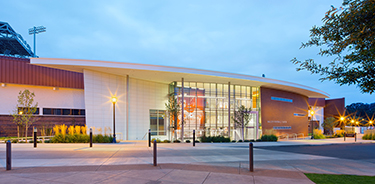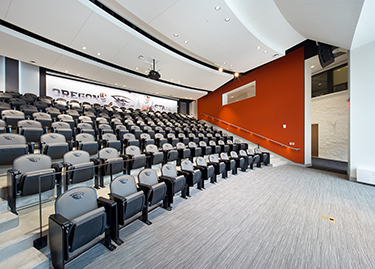|
Subscribe / Renew |
|
|
Contact Us |
|
| ► Subscribe to our Free Weekly Newsletter | |
| home | Welcome, sign in or click here to subscribe. | login |
Construction
| |
 |
August 30, 2018
OSU football center opts for flexible lighting scheme
Stantec

Fiedler
|
There’s nothing like the excitement of a Saturday college game day. But the preparation for on-field success starts behind the scenes.
It’s similar with the Valley Football Center at Oregon State University. Beavers players started enjoying the new facilities after the 2017 football season, but the planning that went into many elements of the design were “behind the scenes.”
Consider the lighting design at the football center, which received a renovation and 55,000-square-foot addition. Our Seattle-area-based Stantec design team worked on the project, which includes a new home team locker room, Hall of Fame exhibit, football program meeting spaces, expanded sports medicine facilities and a new building entrance.
Flexible lighting
Spaces need to be used for various purposes — and be ready for change in the future. The new auditorium, for example, needs to meet many needs: game tape review, lecture and note-taking, and special events — all of which have different lighting requirements.
One key to lighting design is creating layers of light that can provide a palette for many needs. In this case, there are four layers of light:
• Recessed, adjustable overhead LED lights, which can go from classroom-bright to movie-theater dim
• Theatrical-style fixtures that light the podium area, which can be moved for future changes or special events
• Perimeter wall washing to highlight branding areas and provide accent lighting
• Tiny LED downlights integrated into the aisle handrails to provide movie-theater style lighting for safely moving around in the dark
Another key to lighting is simplicity — don’t over-design it. The sports medicine facilities need to be clean, functional and comfortable, and the recessed LED troffers at OSU provide just that.
The clean grid of fixtures is not visibly anchored to any specific equipment, making the space more flexible, and provides illumination that allows trainers to care for players effectively and efficiently. This streamlined design approach also allows budget to be focused on feature areas.
One of these features areas — and perhaps one of the most challenging spaces to light in this project — is the Hall of Fame. Located in part of the existing building that was renovated, the ceiling height is limited by existing conditions, which gave us fewer lighting tools to work with.
Since the Hall of Fame functions like a museum, with exhibits and displays that may change in the future, the lighting needed to be incredibly flexible. Adjustable LED accent lights reside in a recessed channel in the ceiling, which helps visitors notice the exhibit, not the lights.
The channel also gives OSU the ability to move the fixtures if needed. Optical tools on the fixtures (like lenses for various beam spreads and shielding) can be added or taken away from the fixtures to accommodate changing exhibits.
Efficient design
LED lights are the industry standard now. While LED modules themselves last for years, the driver units that regulate power to the low-energy lights typically fail more commonly than the LEDs.
In many applications, the drivers and LEDs are combined into one unit. However, by using a forward-thinking approach in the auditorium, we placed the drivers separate from the LED fixture housings.
By placing the drivers over the aisles rather than over fixed seating, OSU can maintain the fixtures safely and easily. These sorts of decisions are what design is all about — creating user-friendly spaces.
Energy efficiency is also important to our future and to OSU. Using LED products and an energy-efficient design approach, the project interior lighting is designed to 75 percent of what energy code allowed, while the exterior is designed to just 48 percent of the energy code allowance.
Energy savings saves costs on electricity, which allows OSU to repurpose that savings toward other important endeavors.
Beaver branding
School spirit is important to players, students, alumni, potential recruits and your author, a proud alum of OSU.
The first thing visitors experience is the expansive, three-story atrium, which includes a branding wall just as high. Wall-washing luminaires mounted from the ceiling illuminate the wall, which expands OSU’s brand outward to the campus exterior for all to see. Fixtures integrated into the window mullions light the space as well, which make it glow like a lantern at night.
Emphasizing branding with light takes collaboration. The entire design team shared plans for graphics and branding moments to ensure that we highlighted them appropriately and with the proper prioritization.
Strong branding is displayed throughout the locker room, including an illuminated shelf at each locker that highlights every Beaver helmet. Accent lighting at graphic walls adds to individual and team pride — and serves as a recruiting tool.
Just after the project was completed, OSU published a video on social media showing the players entering the locker room for the first time, and it brought a huge smile to my face. I watched with joy as the players practically ran through the space, dancing and taking selfies.
The facility adds to the pride of being part of the Beaver football team.
As a lighting designer and an OSU alumna, it was an absolute pleasure working on this project, and I’m thrilled to have taken part in perpetuating the legacy of OSU through flexible design and up-to-date technology.
The behind-the-scenes design efforts have given OSU a facility that is relevant today and adjustable for the future, supporting the university’s students and football program…and, go Beavs!
Alison Fiedler is an associate and lighting designer at Stantec in Seattle. She is also a proud graduate of Oregon State University.
Other Stories:
- It's much easier for schools to get to net zero
- How enviro consultants can lend your school project a helping hand
- UW Life Sciences Building: giant firs and bird songs offer a one-of-a-kind elevator ride
- 3 keys to building green schools: design, operations and renewables
- Bremerton alternative school breaks down walls to learning
- Studies suggest design really can affect how well students learn
- The view from inside a school: what really makes it safe
- Eastside Prep’s versatile arts hall made for concerts, plays and yoga
- After two decades, UW’s SLU campus nears completion
- How playgrounds make all children feel welcome
- See-through schools spark interest in learning
- Schools have more ways than ever to go green
- Stretch your tight budget by getting creative
- Long-distance teams worked in concert to remake Wyoming school theater




